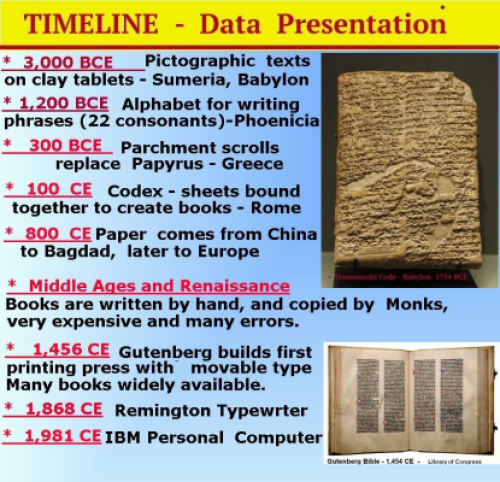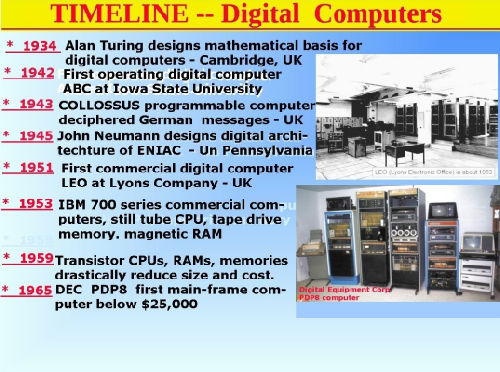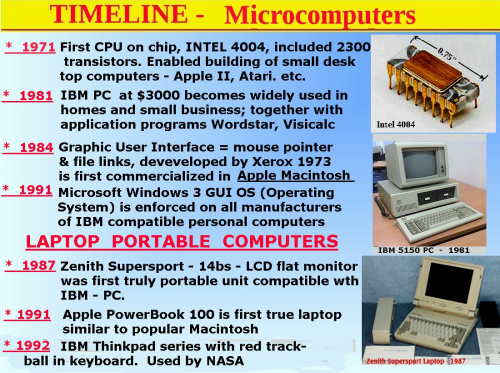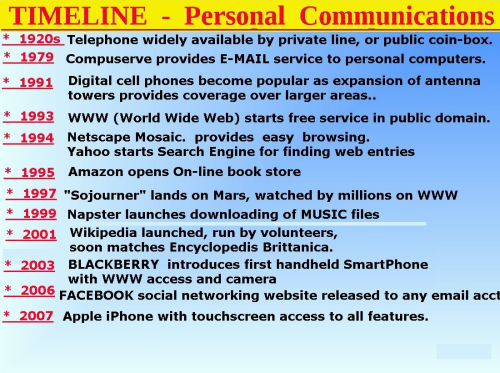

Writing was first recorded on clay tablets over 5,000 years ago.
It took 3,000 years before hand written books were produced.
1,500 more years passed before books were printed.
450 years later typewriters allowed individuals to produce printed pages with copies.
Another 110 years later personal computers allow huge quantities of information to be rapidly evaluated and distributed by an individual.
30 more years and anyone can read information and communicate with anyone, anywhere in the world with a pocket sized device!
What does this exponentially increasing rate of change mean for the future, for our grandchildren?
About 5,500 years ago people,living in the area which is now northern Iraq, learned to write on clay tablets. Early writing was pictographic, each symbol had a a specific meaning, for example "woman", "carry", "water". Within a few hundred years, similar types of writing were developed in Egypt, Indus valley (now part of Pakistan), central China.
The Hammurabi Code, written in Babylon about 1,750BCE, is the oldest known code of Law (depicted in top right corner of the slide). Babylon introduced the 360 degree circle and 60 minute hours, still in use today.
About 1,200 BCE, the Phoenicians, a nation of sailors and traders based in what is now Lebanon, developed a 22 letter alphabet, using symbols for sound and building up words. Our present 26 letter alphabet is based on this 3,200 year old development.

Many copies of the original Gutenberg Bible are still in existence 500 years later, in libraries.
Our present SmartPhones result from the development of Digital Computers, which originated from the ideas of theoretical mathematicians.
The first ever computer algorithms were written by the brilliant British mathematician Ada Lovelace, about 1842 - for the Babbage mechanical computer, which was never completed because of it's complexxity and the inability to produce precision parts at that time.
90 years later the full theoretical concept of modern computers was written by another British mathematician, Alan Turing. The first actual computers were called Turing machines!
The first fully electronic operational programmable computer was built at the University of Pennsylvania for the U.S.Army in 1945. It weighed 30 tons, contained 19,000 vacuum tubes, and cost half million 1945 dollars.

The invention of the transistor at Bell Labs, in New Jersey, in 1959, revolutionized computer design. The bulky, power hungry vacuum tubes were eliminated, reducing size and cost. Now, even small companies could afford to buy main frame computers,
The FINAL REVOLUTION came ONLY 12 years later. In 1971 Intel developed the first microprocessor chip, which included thousands of transistors and other components in one small encapsulated component, replacing dozens of labor intensive, space consuming circuit boards.
The introduction of packaged programs such as Wordstar, Visicalc, and later Windows, made the power of computers available to anyone capable of one finger typing.

| DATE | EVENT |
|---|---|
| 1969 | U.S. Army ARPANET connects research computers of 5 universities. |
| 1981 | TCP/IP international protocol allows ALL computers to communicate with each other. |
| 1981 | ASCII 7-bit character code for all 128 English keyboard characters. |
| 1982 | ASCII code extended to 8 bits to allow most Eurpean characters. Microsoft does not follow standards, and assigns it's own codes! Strange characters appear. |
| 1993 | UNICODE establishes 16-bit code for virtually ALL languages in world. |
| 1993 | WORLD WIDE WEB provides hypertext links for computers to exchange documents, photos, etc. |
| 1994 | W3C establishes world-wide standards organization in Switzerland to ensure trouble-free communications. |
For thousands of years, two people could only communicate directly wih each other if they were close together. Of course they could send written messages, but a reply might take weeks to come back.
In 1876 Graham Bell invented the telephone, which allowed people to talk to each other over long distances. However, it was not until about 1920 that wires and cables were spread around the world to enable universal communication .
Now Smartphones allow two people to not only talk to eac other across the world, but actually see each other during the conversation.
The following table lists other benefits of computers and the World Wide Web, such as email, on-line shopping, on-line misic and movies, family exchanges of info and photos on Facebook and similar sites.

It took several thousand years from the time humans learned to write until they learned to print a book.
It took ONLY 70 years from the building of the first 30 ton computer until everyone can carry a computer in his pocket that has a thousand times larger memory and can access others anywhere in the world!
What will the future bring us? Will we forget how to write? Some high school graduates can barely print a line on a piece of paper, but they can use their thumbs to send text messages as fast as they can talk!
More disturbing is the increasing inability to preserve records.
The Hammurabi Code has survived almost 4,000 years with only small damage.
But the U.S.Census Bureau reports difficulty in retrieving information, ONLY 65 years old, from magnetic tape drives.
Obsolescense is troubling. Try to find a way to retrieve data from a 3 1/2" diskette. let alone a 5 1/2" disk. Try to read a document created in WordStar 35 years ago, on a computer with Windows 10 Operating System!!
Return to top of page.
Return to Biega Home page
History, Genealogy, Opinions
Comparative timeline of Civilizations,
See the progress of mankind through time and around the world.
Concise History of Digital Computers
